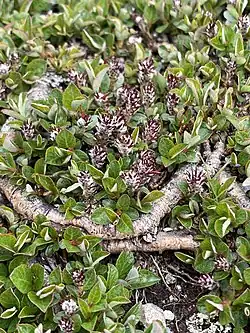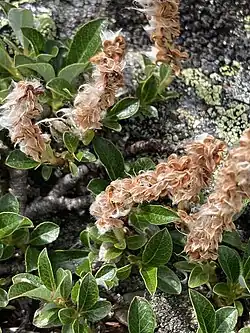Salix uva-ursi
| Salix uva-ursi | |
|---|---|

| |
| In the White Mountain National Forest | |

| |
| Seeding | |
| Scientific classification | |
| Kingdom: | Plantae |
| Clade: | Tracheophytes |
| Clade: | Angiosperms |
| Clade: | Eudicots |
| Clade: | Rosids |
| Order: | Malpighiales |
| Family: | Salicaceae |
| Genus: | Salix |
| Species: | S. uva-ursi
|
| Binomial name | |
| Salix uva-ursi | |
| Synonyms[1] | |
|
List
| |
Salix uva-ursi, the bearberry willow, is a species of flowering plant in the family Salicaceae, native to subarctic and subalpine parts of northeastern North America and Greenland.[1][2] A prostrate shrub, the extreme southern edge of its range is high in the mountains of northern New England[3] and northern New York.[4]
References
- ^ a b "Salix uva-ursi Pursh". Plants of the World Online. Royal Botanic Gardens, Kew. Retrieved 2 October 2022.
- ^ "Salix uva-ursi bearberry willow". The Royal Horticultural Society. 2022. Retrieved 2 October 2022.
Synonyms; Salix apoda misapplied
- ^ "Salix uva-ursi — bearberry willow". Go Botany (3.8). Native Plant Trust. 2022. Retrieved 2 October 2022.
- ^ Buys, John L. (June 1931). "Leafhoppers of Mt. Marcy and Mt. Macintyre, Essex Co., New York (Homoptera, Cicadellidæ)". Journal of the New York Entomological Society. 39 (2): 139–145. Retrieved 19 March 2024.